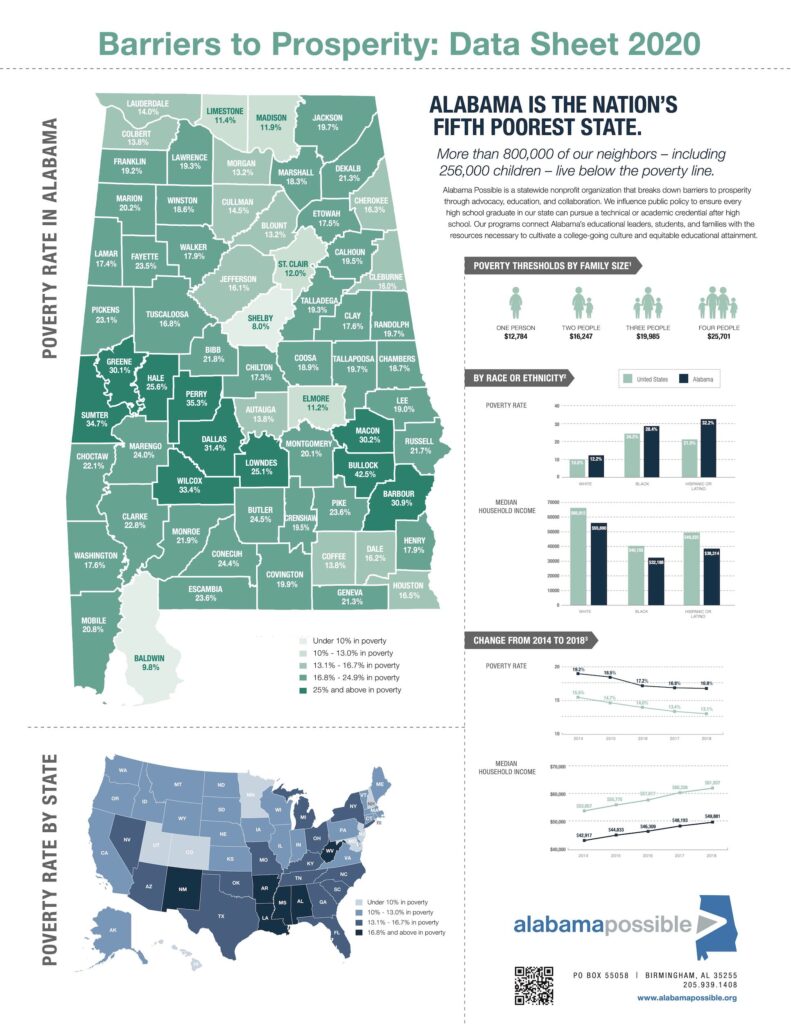Alabama Possible, a statewide nonprofit organization that breaks down barriers to prosperity, today released its 2020 Barriers to Prosperity Data Sheet. This year’s report findings show that more than 800,000 Alabamians, including 256,000 children, live below the federal poverty threshold, which is $25,701 for a family of four.
Poverty has decreased by 2.4 percentage points since it hit a peak of 19.2% in 2014. However, Alabama’s poverty rate of 16.8% remains substantially higher than the national average of 13.1%.
Alabama’s median household income is at a peak of $49,881. However, the gap between Alabama’s median household income and the national median household income stands at $12,056.
Alabama Possible’s 2020 Barriers to Prosperity Data Sheet highlights poverty data from all 67 counties related to educational attainment, employment and food security. The report pairs information from sources including the U.S. Census Bureau, U.S. Bureau of Labor Statistics, Alabama Commission on Higher Education and Alabama Department of Human Resources to generate a comprehensive resource.
This data was gathered before COVID-19 impacted Alabama’s economy beginning in early March. Since then, more than 400,000 Alabamians have lost their jobs.
“While this year’s data sheet shows there is much to be optimistic about, the lines at food pantries show us that reducing poverty is not the same thing as creating prosperity,” said Kristina Scott, executive director of Alabama Possible. “Simply living above the poverty line does not mean that a family is economically secure. The present moment calls us to make sure that everyone can weather this storm, and too many Alabamians are stuck in a cycle of work, get paid, pay bills, repeat.”
Key findings include:
- Alabama is the fifth poorest state in the U.S., and 16.8% of Alabamians live below the federal poverty threshold – a noticeably larger percentage than the national average of 13.1%. The federal poverty thresholds range from $12,784 for one person to $25,701 for a family of four.
- At a county level, ten of Alabama’s 67 counties have a poverty rate higher than 25%. Eight counties have a poverty rate higher than 30%. Only Baldwin and Shelby Counties have a poverty rate of less than 10%.
- Alabama families’ median household income is $49,881, which is $12,056 less than the national median of $61,937.
- African American and Latino people experience higher rates of poverty and lower median household income than white people. While 28.4% of African American people and 32.2% of Latino people live in poverty, only 12.2% of white people do. White people have a median household income of $55,690, while African American people have a median household income of $32,188 and Latino people of $38,314.
Visit AlabamaPossible.org/DataSheet to access Alabama Possible’s 2020 Barriers to Prosperity Data Sheet as a PDF download, explore an interactive digital dashboard, and access discussion questions for use by families, civic organizations, educational institutions, and faith communities.
